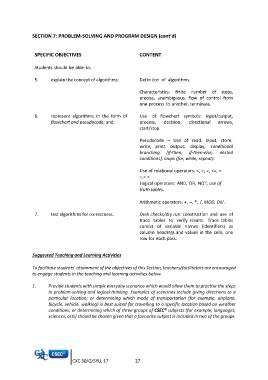Page 1004 - SUBSEC October 2017_Neat
P. 1004
SECTION 7: PROBLEM-SOLVING AND PROGRAM DESIGN (cont’d)
SPECIFIC OBJECTIVES CONTENT
Students should be able to:
5. explain the concept of algorithms; Definition of algorithms.
Characteristics: finite number of steps,
precise, unambiguous, flow of control from
one process to another, terminate.
6. represent algorithms in the form of Use of flowchart symbols: input/output,
flowchart and pseudocode; and, process, decision, directional arrows,
start/stop.
Pseudocode – Use of read, input, store,
write, print, output, display, conditional
branching (if-then, if-then-else, nested
conditions); loops (for, while, repeat).
Use of relational operators: <, >, =, <=, >
=,< >.
Logical operators: AND, OR, NOT; use of
truth tables.
Arithmetic operators: +‚ –‚ *, /, MOD, DIV.
7. test algorithms for correctness. Desk checks/dry run: construction and use of
trace tables to verify results. Trace tables
consist of variable names (identifiers) as
column headings and values in the cells, one
row for each pass.
Suggested Teaching and Learning Activities
To facilitate students’ attainment of the objectives of this Section, teachers/facilitators are encouraged
to engage students in the teaching and learning activities below.
1. Provide students with simple everyday scenarios which would allow them to practise the steps
in problem-solving and logical thinking. Examples of scenarios include giving directions to a
particular location; or determining which mode of transportation (for example, airplane,
bicycle, vehicle, walking) is best suited for travelling to a specific location based on weather
conditions; or determining which of three groups of CSEC® subjects (for example, languages,
sciences, arts) should be chosen given that a favourite subject is included in two of the groups.
CXC 30/G/SYLL 17 27

